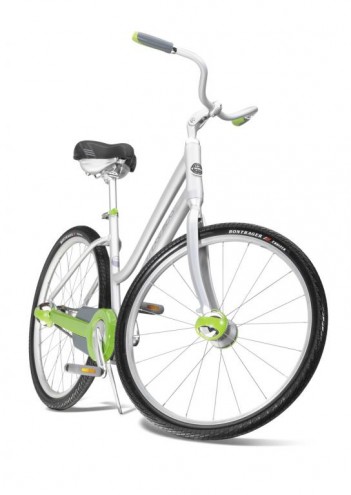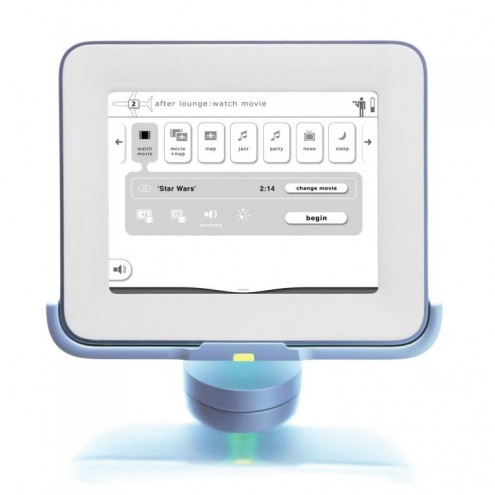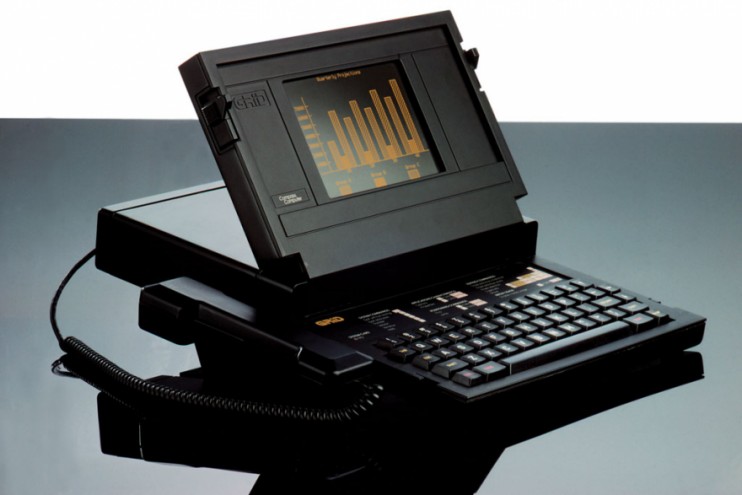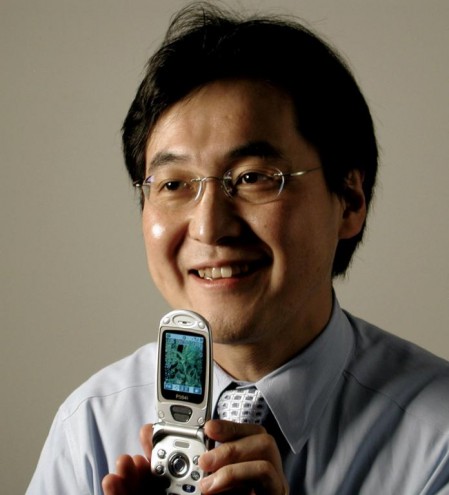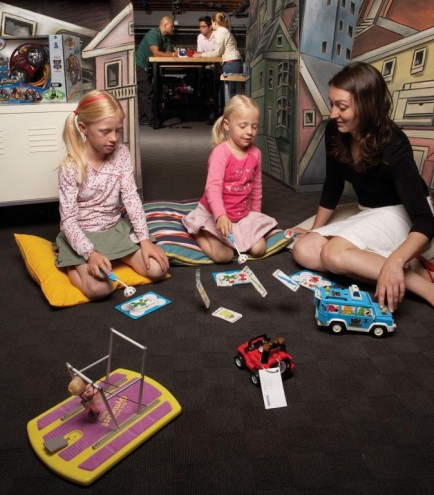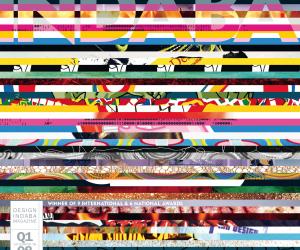First Published in
Design Indaba: You have been credited with designing the first laptop computer, the GRiD Compass in 1980. The GRiD Compass established the model for laptop design. How does one design a classic in the constantly evolving technology landscape?
Bill Moggridge: I started the second office of my design practice in 1979 in California's Silicon Valley and in the following year was fortunate enough to have the opportunity to design the GRiD Compass Computer, the first laptop. At that time, there were a few luggable computers, but they were more the size of a sewing machine than a laptop, and there was no sign yet of the IBM PC or the Apple Macintosh. Back in the mid-1970s, a Xerox Palo Alto Research Center (PARC) researcher, Alan Kay, had conceived of a portable notebook computer that he called the Dynabook, with the dream of seeing it used for education, but Xerox was unwilling to fund the development of a real product as their market strength was in office equipment rather than educational tools. John Ellenby, who had also worked at PARC, founded his own company, GRiD Systems, to build a real notebook-sized machine. He saw the components used in a computer steadily shrinking, and had the vision to realise that there was a huge potential market for people who needed to move around for their work and would like to carry the information in their computers with them. He set out to create a computer that would fit in a briefcase and be usable away from the office.
He first asked me to visualise a design that would help people understand what he imagined, and could be shown to venture capitalists and potential employees. We felt that a three-dimensional model would communicate much more powerfully than drawings, so I designed a concept and made a realistic-looking model out of very unreal materials. The shape was like a fat dictionary that opened like a clamshell, to reveal a flat display on the top half and a keyboard on the bottom. The model did its job of convincing people that the concept had potential, and John successfully raised money and put together an amazingly talented team of founders for GRiD Systems.
We then set about designing and developing the first laptop. My contribution was the physical design of the enclosure, and the way that the screen was hinged to fold down over the keyboard for carrying. This geometry accounted for only one of the 43 items of innovation in the utility patent that we were awarded. Most of these innovations are taken for granted today, but they were new at the time, for example: the flat electroluminescent graphic display, the low-profile keyboard, bubble memory and the die-cast magnesium enclosure. The metal housing offered a combination of strength and lightness, creating a tough machine that was sent up in space shuttles and dropped from military helicopters.
Is this inherent in the term you coined, "interaction design"?
When the first 25 working prototypes of the GRiD Compass Computer were ready, I took one home and started using it. I soon realised that the physical design that I had spent so much time on was insignificant when compared to the design of the operating system and the interactive software. I only noticed the physical design for a few minutes in each session, but was buried in the delights and frustrations of the interactive behaviours for hours at a time. That made me decide to learn how to design interactions. The need for a new discipline was obvious when I thought about the experience of using this laptop as a whole, including both the physical machine and the software. I realised that the values of design applied equally to both the physical and digital aspects of the problem, and that I knew a lot about the techniques and tools for designing physical objects, whereas I did not know about the equivalent techniques and tools for designing in the digital realm.
Gradually, over the next few years, I learnt enough about the design challenges in the digital realm to see how a design discipline could be developed. I put together a team of interaction designers in my studio in San Francisco. The design disciplines share a common process of creative visualisation and synthesis of solutions. All designers work with the subjective and qualitative values of aesthetics as well as the functional values of problem solving. Architects, product designers, graphic designers, interaction designers and all of the other design disciplines, share this process. They are drawn to these disciplines because they are people with similar talents, hovering between thinking of themselves as artists or problem-solvers, good at lateral thinking, and the synthesis of solutions from a basis of tacit knowledge.
They are in different disciplines because they have been educated to know about different technologies. They all need to be experts in understanding what people need and desire, but their technical expertise comes from different sources. The architect needs to understand the structure of buildings and the manipulation of space, the product designer needs to understand how to design for mass-produced objects, the graphic designer needs to understand how to present information in two dimensions and the technologies of print, and the interaction designer needs to understand the structure of software behaviours, electronically enabled services and environments.
At first we thought of calling this new discipline "Softface" to communicate the ideas of software and interface, but a friend said: "Softface, that sounds like a stuffed doll!" Interaction design seemed a better option, as it related more closely to industrial design; the label stuck and more people started to use it, so that by the end of the Eighties it was widely recognised.
"Interaction design" has been defined as aiming to do for the virtual world what industrial design does for the physical. What are the differences and challenges of the two worlds?
Both disciplines focus on people. Interaction design is the equivalent of industrial design in that the first concern of the designer is the human values of the people who will use the design - the aesthetics, subjective and qualitative values, and human factors. The designer creates a solution to give pleasure and lasting satisfaction, and hence to fit the market and make businesses successful.
The difference between the disciplines lies in the information, tools and methods that you need in order to design. The interaction designer needs to understand the ways in which people think about the abstract virtual world. What is familiar to the user in this new space of software and algorithms? What conceptual models will help people know how to operate a computer, a digital camera, a VCR or a 500 channel TV? How can we design screens, animations and behaviours? How can we provide responses from the smart machine that are meaningful? All this takes some learning, but the core skills of design remain common across design disciplines.
You have written extensively about the design challenges of the technology explosion in your book Designing Interactions. What are the most significant technological inventions that have changed our interaction with the world?
In his interview in the book, Terry Winograd suggests that we interact with the world around us in three main ways, manipulation, locomotion and conversation. In manipulation you move things around with your hands; for locomotion you move yourself from place to place; and in conversation, you say something, and another person says something back. Terry explains the relationship between those three interactions and computers:
"If you look at computers, all three of those metaphors are present. The early ordinary timesharing system was conversation; I type something in, it types something back. The Xerox Star, the Macintosh, that whole line of things was manipulation; you actually move things around. As the Internet became popular and shifted to the Web as we now know it, the metaphor shifted more than the technology.
I used to say things like, 'I'm going to retrieve a file from somebody else's computer and bring it up on my screen.'
That's manipulation; I retrieve it, I bring it up.
Now I say, 'I'm going to go to their home page.' I'm doing exactly the same thing. I'm retrieving a file from their computer and I'm printing it up on my screen, but I've shifted my thinking away from doing things to moving. There's a space, there's a place. "
The most important inventions in conversation were timesharing and email, in manipulation it was the mouse for input and the desktop for screens, and in locomotion it was the Internet, with Google in the lead, based on their PageRank algorithm.
You have said that the iPod is the stellar design of today. How did the iPhone match up in your opinion? What is the next stellar design?
The iPhone and the iPod Touch are indeed stellar! The physical design of the slim and elegant slabs of metal and glass have star qualities. The interaction design revels in the delicious vividness of a full-colour high-resolution screen, which you can manipulate by touch and gesture, with animations and screen behaviours that flow with elegant grace - yes, that is really stellar! The design shows what is possible when all of the elements of the product are integrated with each other - the physical form, the operating system, the interaction design, the access to phone, wireless Internet, syncing from your computer and the access to music and video. Thank you, Apple!
The next stellar design will need to set a precedent of similar magnitude if it is to compete. Those opportunities happen very rarely, as most innovation is closer to evolution than revolution. Technology continues to improve dramatically, as predicted by Moore's law, so the enabling infrastructure for new stardom is likely to come, but I think it may come with a shift in context; perhaps nanotechnology applied to problems of sustainability? Your guess is probably as good as mine.
It is predicted that 2008 is the year that the third screen (the mobile screen) will increasingly rival the first screen (TV). How do you see the mobile technology explosion transforming interactions and what do you think are the design challenges?
In 2002, more than a quarter of the total population of Japan subscribed to the i-mode service, an amazing success story for a service that was only a few years old. For my book, I interviewed Takeshi Natsuno, the entrepreneur responsible for developing the business model for this dramatic leap forward in the success of the third screen, successfully integrating Internet access with cell phones. Here is a quote from the interview:
"To realise the really useful and really enjoyable service, the handset design is very important, because the handset can represent your taste. Of course, this is a very technical tool, but at the same time you have to have this tool all the time. That means that you can show your lifestyle by the selection of the handset. What kind of handset you are using and what kind of content you are using reflect some of your life. That's why we are always making a really heavy effort for the tiny details of this handset design. This kind of latch is very important. Feel is very important. The shape, how round it should be, is very important. The little things are very important."
Natsuno is very clear about the business model, where the handset design is only part of the full value chain. It extends from the handset up to the network service, and only then up to the Internet-based content provider. In 2002, no single company was capable of operating across the whole of the value chain. In the case of the i-mode service, they were in the middle, unable to create the content, or to design the handset. Apple has broken through that barrier with the iPhone, allowing other companies in mobile technology to see the value of an integrated approach to the design of the complete system. Perhaps this breakthrough will cause many companies to try to offer mobile products that are easy and enjoyable to use, but the challenges of working at so many levels will remain daunting.
Beyond even the third screen, the world is demanding increased digital interfaces for previously inert objects. Where do you think the future is taking us?
The Internet is increasingly accessible from personal and portable objects, based on better wireless technology - so ubiquitous computing is with us at last. The future is full of connected objects that we can take wherever and whenever we want to go.
The idea that we have of moving around the Internet, of going to sites and looking at things, is very appropriate while the Web stays a read-only medium, but it will not serve us well when we start to realise the interactive potential of networks. We are seeing changes starting already, as we find more and more of the Web offering real interactivity instead of just browsing. We can go places and then do things. "Conversation" is also starting to emerge as a relevant metaphor for designing on the Web, as the potential for community starts to be fulfilled. We can visit chatrooms, find like-minded people to share our interests or play Massively-Multiplayer Online Role-Playing Games (MMORPG), in which a large number of players interact with us in a virtual world. I think that the Web will realise its interactive potential when we feel able to fluently move between these three types of interaction: visiting places; doing things when we arrive; and collaborating and conversing with other people who are there.
Some people are predicting a technology saturation point and catchphrases such as de-teching, e-clutter and Facebook suicides are already pointing to people missing sunshine-time and fleshmeets. Do you think it's a real threat?
We are sensory beings, enjoying feelings and sensibilities that defy our comprehension. I can't imagine a world where people are willing to say goodbye to true reality and become satisfied by the artificial alternatives offered by digital technology. Do you remember all of the hype about virtual reality in the late-1980s and early-1990s, with predictions of VR replacing the need for face-to-face interactions? It never happened and it's not likely to happen any time soon! Fleshmeets are here to stay! Perhaps the biggest challenge that we face is to remember to turn off our connected devices. When we are enjoying our sunshine-time, will we be wise enough to flip the switch, go offline and enjoy privacy, revelling in the warming rays and golden light?
Design Indaba: You have been credited with designing the first laptop computer, the GRiD Compass in 1980. The GRiD Compass established the model for laptop design. How does one design a classic in the constantly evolving technology landscape?
Bill Moggridge: I started the second office of my design practice in 1979 in California's Silicon Valley and in the following year was fortunate enough to have the opportunity to design the GRiD Compass Computer, the first laptop. At that time, there were a few luggable computers, but they were more the size of a sewing machine than a laptop, and there was no sign yet of the IBM PC or the Apple Macintosh. Back in the mid-1970s, a Xerox Palo Alto Research Center (PARC) researcher, Alan Kay, had conceived of a portable notebook computer that he called the Dynabook, with the dream of seeing it used for education, but Xerox was unwilling to fund the development of a real product as their market strength was in office equipment rather than educational tools. John Ellenby, who had also worked at PARC, founded his own company, GRiD Systems, to build a real notebook-sized machine. He saw the components used in a computer steadily shrinking, and had the vision to realise that there was a huge potential market for people who needed to move around for their work and would like to carry the information in their computers with them. He set out to create a computer that would fit in a briefcase and be usable away from the office.
He first asked me to visualise a design that would help people understand what he imagined, and could be shown to venture capitalists and potential employees. We felt that a three-dimensional model would communicate much more powerfully than drawings, so I designed a concept and made a realistic-looking model out of very unreal materials. The shape was like a fat dictionary that opened like a clamshell, to reveal a flat display on the top half and a keyboard on the bottom. The model did its job of convincing people that the concept had potential, and John successfully raised money and put together an amazingly talented team of founders for GRiD Systems.
We then set about designing and developing the first laptop. My contribution was the physical design of the enclosure, and the way that the screen was hinged to fold down over the keyboard for carrying. This geometry accounted for only one of the 43 items of innovation in the utility patent that we were awarded. Most of these innovations are taken for granted today, but they were new at the time, for example: the flat electroluminescent graphic display, the low-profile keyboard, bubble memory and the die-cast magnesium enclosure. The metal housing offered a combination of strength and lightness, creating a tough machine that was sent up in space shuttles and dropped from military helicopters.
Is this inherent in the term you coined, "interaction design"?
When the first 25 working prototypes of the GRiD Compass Computer were ready, I took one home and started using it. I soon realised that the physical design that I had spent so much time on was insignificant when compared to the design of the operating system and the interactive software. I only noticed the physical design for a few minutes in each session, but was buried in the delights and frustrations of the interactive behaviours for hours at a time. That made me decide to learn how to design interactions. The need for a new discipline was obvious when I thought about the experience of using this laptop as a whole, including both the physical machine and the software. I realised that the values of design applied equally to both the physical and digital aspects of the problem, and that I knew a lot about the techniques and tools for designing physical objects, whereas I did not know about the equivalent techniques and tools for designing in the digital realm.
Gradually, over the next few years, I learnt enough about the design challenges in the digital realm to see how a design discipline could be developed. I put together a team of interaction designers in my studio in San Francisco. The design disciplines share a common process of creative visualisation and synthesis of solutions. All designers work with the subjective and qualitative values of aesthetics as well as the functional values of problem solving. Architects, product designers, graphic designers, interaction designers and all of the other design disciplines, share this process. They are drawn to these disciplines because they are people with similar talents, hovering between thinking of themselves as artists or problem-solvers, good at lateral thinking, and the synthesis of solutions from a basis of tacit knowledge.
They are in different disciplines because they have been educated to know about different technologies. They all need to be experts in understanding what people need and desire, but their technical expertise comes from different sources. The architect needs to understand the structure of buildings and the manipulation of space, the product designer needs to understand how to design for mass-produced objects, the graphic designer needs to understand how to present information in two dimensions and the technologies of print, and the interaction designer needs to understand the structure of software behaviours, electronically enabled services and environments.
At first we thought of calling this new discipline "Softface" to communicate the ideas of software and interface, but a friend said: "Softface, that sounds like a stuffed doll!" Interaction design seemed a better option, as it related more closely to industrial design; the label stuck and more people started to use it, so that by the end of the Eighties it was widely recognised.
"Interaction design" has been defined as aiming to do for the virtual world what industrial design does for the physical. What are the differences and challenges of the two worlds?
Both disciplines focus on people. Interaction design is the equivalent of industrial design in that the first concern of the designer is the human values of the people who will use the design - the aesthetics, subjective and qualitative values, and human factors. The designer creates a solution to give pleasure and lasting satisfaction, and hence to fit the market and make businesses successful.
The difference between the disciplines lies in the information, tools and methods that you need in order to design. The interaction designer needs to understand the ways in which people think about the abstract virtual world. What is familiar to the user in this new space of software and algorithms? What conceptual models will help people know how to operate a computer, a digital camera, a VCR or a 500 channel TV? How can we design screens, animations and behaviours? How can we provide responses from the smart machine that are meaningful? All this takes some learning, but the core skills of design remain common across design disciplines.
You have written extensively about the design challenges of the technology explosion in your book Designing Interactions. What are the most significant technological inventions that have changed our interaction with the world?
In his interview in the book, Terry Winograd suggests that we interact with the world around us in three main ways, manipulation, locomotion and conversation. In manipulation you move things around with your hands; for locomotion you move yourself from place to place; and in conversation, you say something, and another person says something back. Terry explains the relationship between those three interactions and computers:
"If you look at computers, all three of those metaphors are present. The early ordinary timesharing system was conversation; I type something in, it types something back. The Xerox Star, the Macintosh, that whole line of things was manipulation; you actually move things around. As the Internet became popular and shifted to the Web as we now know it, the metaphor shifted more than the technology.
I used to say things like, 'I'm going to retrieve a file from somebody else's computer and bring it up on my screen.'
That's manipulation; I retrieve it, I bring it up.
Now I say, 'I'm going to go to their home page.' I'm doing exactly the same thing. I'm retrieving a file from their computer and I'm printing it up on my screen, but I've shifted my thinking away from doing things to moving. There's a space, there's a place. "
The most important inventions in conversation were timesharing and email, in manipulation it was the mouse for input and the desktop for screens, and in locomotion it was the Internet, with Google in the lead, based on their PageRank algorithm.
You have said that the iPod is the stellar design of today. How did the iPhone match up in your opinion? What is the next stellar design?
The iPhone and the iPod Touch are indeed stellar! The physical design of the slim and elegant slabs of metal and glass have star qualities. The interaction design revels in the delicious vividness of a full-colour high-resolution screen, which you can manipulate by touch and gesture, with animations and screen behaviours that flow with elegant grace - yes, that is really stellar! The design shows what is possible when all of the elements of the product are integrated with each other - the physical form, the operating system, the interaction design, the access to phone, wireless Internet, syncing from your computer and the access to music and video. Thank you, Apple!
The next stellar design will need to set a precedent of similar magnitude if it is to compete. Those opportunities happen very rarely, as most innovation is closer to evolution than revolution. Technology continues to improve dramatically, as predicted by Moore's law, so the enabling infrastructure for new stardom is likely to come, but I think it may come with a shift in context; perhaps nanotechnology applied to problems of sustainability? Your guess is probably as good as mine.
It is predicted that 2008 is the year that the third screen (the mobile screen) will increasingly rival the first screen (TV). How do you see the mobile technology explosion transforming interactions and what do you think are the design challenges?
In 2002, more than a quarter of the total population of Japan subscribed to the i-mode service, an amazing success story for a service that was only a few years old. For my book, I interviewed Takeshi Natsuno, the entrepreneur responsible for developing the business model for this dramatic leap forward in the success of the third screen, successfully integrating Internet access with cell phones. Here is a quote from the interview:
"To realise the really useful and really enjoyable service, the handset design is very important, because the handset can represent your taste. Of course, this is a very technical tool, but at the same time you have to have this tool all the time. That means that you can show your lifestyle by the selection of the handset. What kind of handset you are using and what kind of content you are using reflect some of your life. That's why we are always making a really heavy effort for the tiny details of this handset design. This kind of latch is very important. Feel is very important. The shape, how round it should be, is very important. The little things are very important."
Natsuno is very clear about the business model, where the handset design is only part of the full value chain. It extends from the handset up to the network service, and only then up to the Internet-based content provider. In 2002, no single company was capable of operating across the whole of the value chain. In the case of the i-mode service, they were in the middle, unable to create the content, or to design the handset. Apple has broken through that barrier with the iPhone, allowing other companies in mobile technology to see the value of an integrated approach to the design of the complete system. Perhaps this breakthrough will cause many companies to try to offer mobile products that are easy and enjoyable to use, but the challenges of working at so many levels will remain daunting.
Beyond even the third screen, the world is demanding increased digital interfaces for previously inert objects. Where do you think the future is taking us?
The Internet is increasingly accessible from personal and portable objects, based on better wireless technology - so ubiquitous computing is with us at last. The future is full of connected objects that we can take wherever and whenever we want to go.
The idea that we have of moving around the Internet, of going to sites and looking at things, is very appropriate while the Web stays a read-only medium, but it will not serve us well when we start to realise the interactive potential of networks. We are seeing changes starting already, as we find more and more of the Web offering real interactivity instead of just browsing. We can go places and then do things. "Conversation" is also starting to emerge as a relevant metaphor for designing on the Web, as the potential for community starts to be fulfilled. We can visit chatrooms, find like-minded people to share our interests or play Massively-Multiplayer Online Role-Playing Games (MMORPG), in which a large number of players interact with us in a virtual world. I think that the Web will realise its interactive potential when we feel able to fluently move between these three types of interaction: visiting places; doing things when we arrive; and collaborating and conversing with other people who are there.
Some people are predicting a technology saturation point and catchphrases such as de-teching, e-clutter and Facebook suicides are already pointing to people missing sunshine-time and fleshmeets. Do you think it's a real threat?
We are sensory beings, enjoying feelings and sensibilities that defy our comprehension. I can't imagine a world where people are willing to say goodbye to true reality and become satisfied by the artificial alternatives offered by digital technology. Do you remember all of the hype about virtual reality in the late-1980s and early-1990s, with predictions of VR replacing the need for face-to-face interactions? It never happened and it's not likely to happen any time soon! Fleshmeets are here to stay! Perhaps the biggest challenge that we face is to remember to turn off our connected devices. When we are enjoying our sunshine-time, will we be wise enough to flip the switch, go offline and enjoy privacy, revelling in the warming rays and golden light?

